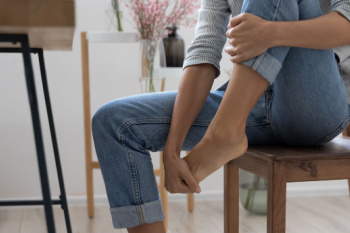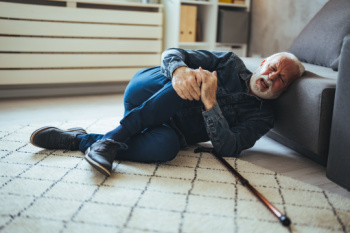Items filtered by date: March 2024
Wounds That Don't Heal Need to Be Checked
Reasons Your Ankle May Hurt

Ankle pain can stem from various sources, including minor injuries like strains and sprains. More severe conditions, such as an Achilles tendon rupture, a fracture, and muscle or ligament damage, also result in ankle pain. Symptoms range from sharp, acute pain to persistent discomfort and swelling around the ankle. The inability to put weight on the foot is another indication of an ankle injury. While some injuries may improve with home care, persistent or severe pain requires professional evaluation. Podiatrists specialize in diagnosing and treating ankle conditions and offer personalized treatment plans tailored to your specific needs. Addressing the underlying cause of your pain is essential for effective management and restoring the optimal function of your ankle. If you're experiencing ankle pain that is affecting your daily activities, it's suggested that you make an appointment with a podiatrist for a comprehensive assessment.
Ankle pain can be caused by a number of problems and may be potentially serious. If you have ankle pain, consult with James Pak, DPM from California. Our doctor will assess your condition and provide you with quality foot and ankle treatment.
Ankle pain is any condition that causes pain in the ankle. Due to the fact that the ankle consists of tendons, muscles, bones, and ligaments, ankle pain can come from a number of different conditions.
Causes
The most common causes of ankle pain include:
- Types of arthritis (rheumatoid, osteoarthritis, and gout)
- Ankle sprains
- Broken ankles
- Achilles tendonitis
- Achilles tendon rupture
- Stress fractures
- Bursitis
- Tarsal tunnel syndrome
- Plantar fasciitis
Symptoms
Symptoms of ankle injury vary based upon the condition. Pain may include general pain and discomfort, swelling, aching, redness, bruising, burning or stabbing sensations, and/or loss of sensation.
Diagnosis
Due to the wide variety of potential causes of ankle pain, podiatrists will utilize a number of different methods to properly diagnose ankle pain. This can include asking for personal and family medical histories and of any recent injuries. Further diagnosis may include sensation tests, a physical examination, and potentially x-rays or other imaging tests.
Treatment
Just as the range of causes varies widely, so do treatments. Some more common treatments are rest, ice packs, keeping pressure off the foot, orthotics and braces, medication for inflammation and pain, and surgery.
If you have any questions, please feel free to contact our office located in Anaheim, CA . We offer the newest diagnostic and treatment technologies for all your foot care needs.
Managing Crooked Toes

Are you often hiding your feet in closed-toe shoes, even at home? Crooked toes, including conditions like hammertoes, claw toes, and mallet toes, can cause embarrassment and discomfort for many individuals. They often result from a combination of genetic predisposition, wearing ill-fitting shoes, or underlying foot deformities. Besides the physical appearance, crooked toes can lead to pain, corns, and calluses due to friction against the footwear. Podiatrists offer various approaches to relieve symptoms and correct crooked toes. Conservative treatments may include wearing wider shoes, padding to reduce pressure, and custom orthotics to improve toe alignment. In more severe cases, surgical options like toe-straightening procedures may be recommended to alleviate pain and restore normal toe function. If you have bothersome crooked toes, it is suggested that you make an appointment with a podiatrist for tailored treatment and relief.
Toe pain can disrupt your daily activities. If you have any concerns, contact James Pak, DPM of California. Our doctor can provide the care you need to keep you pain-free and on your feet.
What Causes Toe Pain?
Most severe toe pain is caused due to a sports injury, trauma from dropping something heavy on the toe, or bumping into something rigid. Other problems can develop over time for various reasons.
Toe pain can be caused by one or more ailments. The most common include:
- Trauma
- Sports injury
- Wearing shoes that are too tight
- Arthritis
- Gout
- Corns and calluses
- Hammertoe
- Bunions
- Blisters
- Ingrown toenails
- Sprains
- Fractures (broken bones)
- Dislocations
When to See a Podiatrist
- Severe pain
- Persistent pain that lasts more than a week
- Signs of infection
- Continued swelling
- Pain that prevents walking
Diagnosis
In many cases the cause of toe pain is obvious, but in others, a podiatrist may want to use more advanced methods to determine the problem. These can range from simple visual inspections and sensation tests to X-rays and MRI scans. Prior medical history, family medical history, and any recent physical traumatic events will all be taken into consideration for a proper diagnosis.
Treatment
Treatments for toe pain and injuries vary and may include shoe inserts, padding, taping, medicines, injections, and in some cases, surgery. If you believe that you have broken a toe, please see a podiatrist as soon as possible.
If you have any questions please feel free to contact our office located in Anaheim, CA . We offer the newest diagnostic tools and technology to treat your foot and ankle needs.
Dealing With an Ankle Sprain

Ankle sprains occur when the ligaments in your ankle are stretched or torn beyond their intended limits, leading to varying degrees of pain and swelling. Ankle sprains are typically categorized into three grades, ranging from mild stretching to full tearing of ligaments, with Grade III sprains often requiring medical intervention, such as a brace or in some cases, surgery. While certain self-care measures help to ease symptoms, seeking expert care from a podiatrist is essential for a proper diagnosis, treatment, and prevention of chronic ankle sprains. A podiatrist may recommend using splints, casts, or braces, along with rehab exercises to aid in recovery and prevent future sprains. It is especially important to monitor symptoms closely and seek medical attention if pain persists or worsens, or if there are signs of numbness, weakness, or other concerning symptoms. With proper care and guidance from a podiatrist, most ankle sprains can heal effectively. If you have a sprained ankle, it is suggested that you seek immediate attention from a podiatrist who is trained to deal with this injury.
Although ankle sprains are common, they aren’t always minor injuries. If you need your ankle injury looked at, contact James Pak, DPM from California. Our doctor can provide the care you need to keep you pain-free and on your feet.
How Does an Ankle Sprain Occur?
Ankle sprains are the result of a tear in the ligaments within the ankle. These injuries may happen when you make a rapid shifting movement while your foot is planted. A less common way to sprain your ankle is when your ankle rolls inward while your foot turns outward.
What Are the Symptoms?
- Pain at the sight of the tear
- Bruising/Swelling
- Ankle area is tender to touch
- In severe cases, may hear/feel something tear
- Skin discoloration
Preventing a Sprain
- Wearing appropriate shoes for the occasion
- Stretching before exercises and sports
- Knowing your limits
Treatment of a Sprain
In many cases, the RICE method (Rest, Ice, Compression, and Elevate) is used to treat ankle sprains. However, you should see a podiatrist to see which treatment option would work best with your injury. In severe cases, surgery may be required.
It is important to ask your doctor about rehab options after you receive treatment for your injury. Stretching, strength training, and balance exercises may help the ankle heal while also preventing further injury.
If you have any questions, please feel free to contact our office located in Anaheim, CA . We offer the newest diagnostic and treatment technologies for all your foot care needs.
Preventing Elderly Falls With the Right Shoes
 Choosing the right footwear can help prevent falls among the elderly. Proper shoes contribute significantly to stability and overall foot health. Shoes with non-slip soles provide better traction, reducing the risk of slipping on various surfaces. Additionally, supportive shoes with a firm heel counter and adequate arch support help maintain balance and prevent ankle injuries. For elderly individuals, shoes with adjustable straps or laces ensure a secure fit, minimizing the chances of tripping. Narrow and high-heeled shoes, as well as shoes without straps or laces, are associated with a greater risk of falling. When there are conditions that affect the feet, such as diabetes and arthritis, appropriate footwear is even more important. Better shoes can also help elderly people maintain independence and mobility. If you are trying to prevent yourself or someone else from falling, make an appointment with a podiatrist who can assess foot issues and offer suggestions for your next pair of shoes.
Choosing the right footwear can help prevent falls among the elderly. Proper shoes contribute significantly to stability and overall foot health. Shoes with non-slip soles provide better traction, reducing the risk of slipping on various surfaces. Additionally, supportive shoes with a firm heel counter and adequate arch support help maintain balance and prevent ankle injuries. For elderly individuals, shoes with adjustable straps or laces ensure a secure fit, minimizing the chances of tripping. Narrow and high-heeled shoes, as well as shoes without straps or laces, are associated with a greater risk of falling. When there are conditions that affect the feet, such as diabetes and arthritis, appropriate footwear is even more important. Better shoes can also help elderly people maintain independence and mobility. If you are trying to prevent yourself or someone else from falling, make an appointment with a podiatrist who can assess foot issues and offer suggestions for your next pair of shoes.
Preventing falls among the elderly is very important. If you are older and have fallen or fear that you are prone to falling, consult with James Pak, DPM from California. Our doctor will assess your condition and provide you with quality advice and care.
Every 11 seconds, an elderly American is being treated in an emergency room for a fall related injury. Falls are the leading cause of head and hip injuries for those 65 and older. Due to decreases in strength, balance, senses, and lack of awareness, elderly persons are very susceptible to falling. Thankfully, there are a number of things older persons can do to prevent falls.
How to Prevent Falls
Some effective methods that older persons can do to prevent falls include:
- Enrolling in strength and balance exercise program to increase balance and strength
- Periodically having your sight and hearing checked
- Discuss any medications you have with a doctor to see if it increases the risk of falling
- Clearing the house of falling hazards and installing devices like grab bars and railings
- Utilizing a walker or cane
- Wearing shoes that provide good support and cushioning
- Talking to family members about falling and increasing awareness
Falling can be a traumatic and embarrassing experience for elderly persons; this can make them less willing to leave the house, and less willing to talk to someone about their fears of falling. Doing such things, however, will increase the likelihood of tripping or losing one’s balance. Knowing the causes of falling and how to prevent them is the best way to mitigate the risk of serious injury.
If you have any questions, please feel free to contact our office located in Anaheim, CA . We offer the newest diagnostic and treatment technologies for all your foot care needs.

